Cooldown Spaces: Essential Strategies for Calming Children
Updated On: October 24, 2025 by Aaron Connolly
What Are Cooldown Spaces?
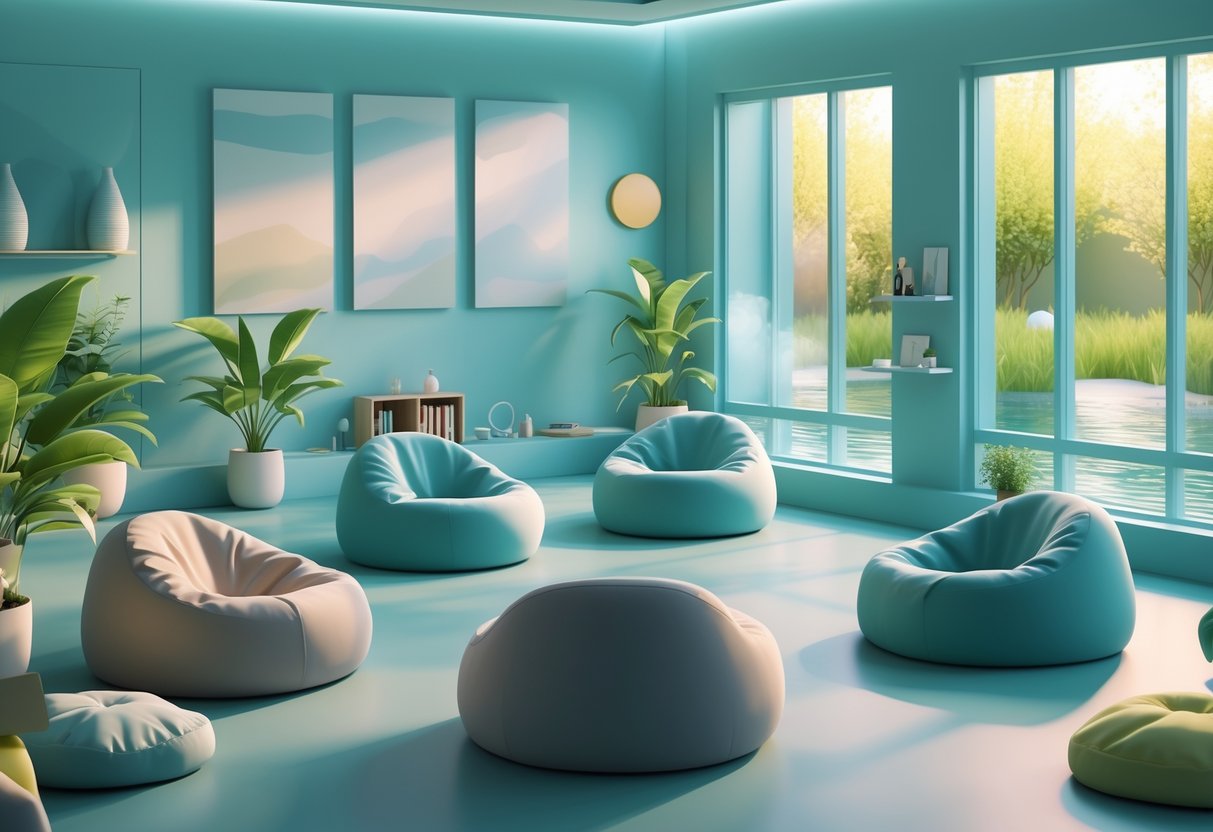
Cooldown spaces are quiet spots where kids can go when they’re upset, angry, or overwhelmed. These areas help them learn to manage their emotions and give their minds a break before they jump back into things.
Key Characteristics
A good cooldown space has a few must-haves. It should be quiet and away from the busiest parts of the room or house.
Most have soft things like cushions, bean bags, or stuffed animals. Kids just seem to relax more easily when they have something cozy.
Temperature control is important. The spot should feel comfortable—not too hot, not too cold.
You’ll often find calming activities:
- Fidget toys or stress balls
- Quiet books or picture books
- Coloring materials
- Glitter jars or timers
- Soft music or headphones
You don’t need a huge area. Even a corner with a tent, a reading nook, or a special chair can do the trick.
Purpose and Benefits
We want kids to understand that their brains can’t work well when they’re upset. Taking a break to calm down helps them think clearly again.
Cooldown spaces teach self-regulation skills. Kids start to notice when they need a break and figure out how to help themselves.
Just knowing the space is there can take some pressure off. Kids feel safer when they know they have somewhere to go.
After a break, kids usually come back ready to solve problems or get back to learning. They’re not carrying all that frustration with them.
Letting kids decide when to use the space and when to return shows respect for their feelings.
Common Settings
You’ll find cooldown spaces in lots of places where kids hang out. Classrooms often have calm-down corners with soft seats and quiet things to do.
At home, families set up these spots in:
- Bedrooms
- Playrooms
- Family room corners
- Reading nooks
The exact location isn’t as important as making it feel separate from busy areas. Some families even use portable kits so the space can move around.
Schools might call these areas “cozy corners,” “calm down areas,” or “break spaces.” Sometimes teachers let kids help pick the name—like “Hawaii” or “Happy Place.”
Sensory rooms in special needs settings do the same job. They just have extra tools for kids who need more support.
Why Cooldown Spaces Matter for Children
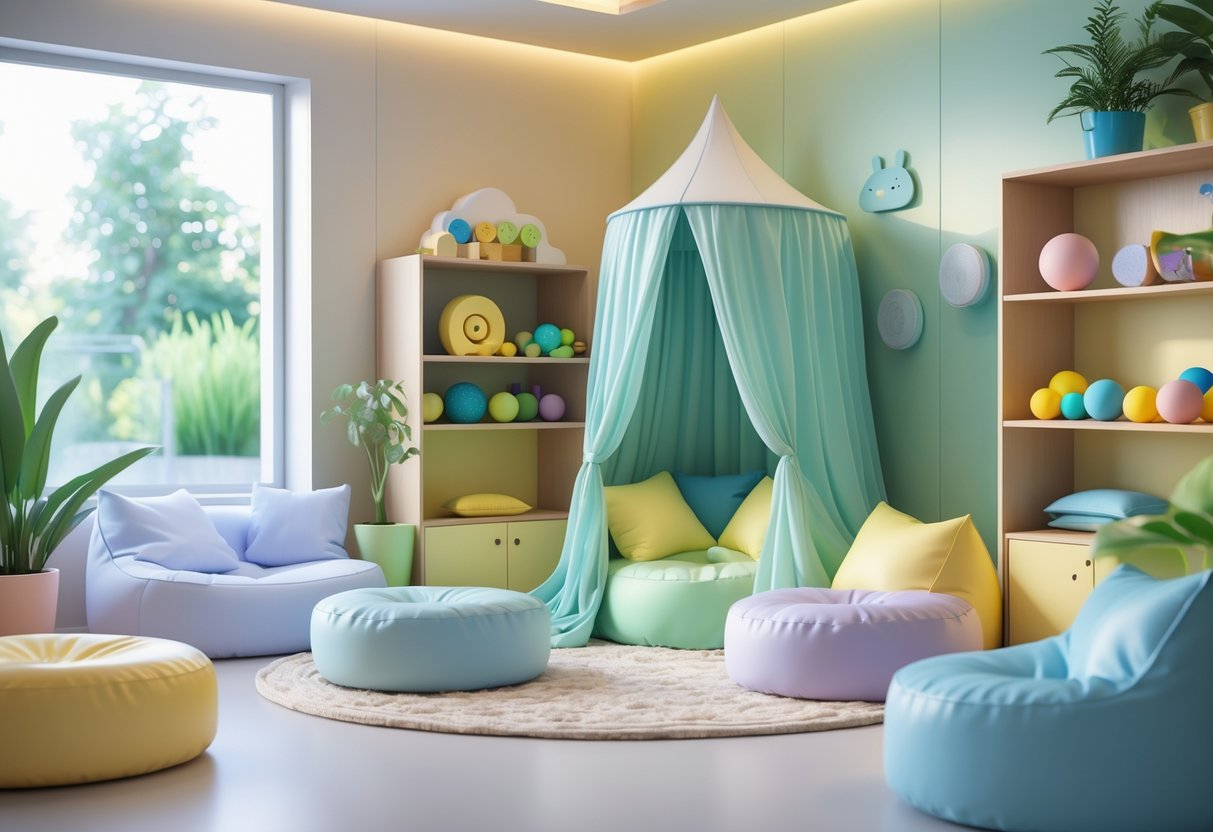
Cooldown spaces give kids real tools to handle big emotions. These safe places help them learn self-regulation and make the whole environment a bit more peaceful.
Supporting Emotional Development
Kids feel things deeply, but they don’t always know what to do with those feelings. A cooldown space gives them a safe spot to figure it out.
When we offer mirrors, emotion charts, and books about feelings, kids start connecting what they see in the mirror with how they feel inside. That’s how they build emotional vocabulary.
Key emotional skills kids pick up:
- Naming different emotions
- Figuring out what sets them off
- Realizing all emotions are normal
- Finding healthy ways to express feelings
The space reminds kids that having strong feelings isn’t wrong. Everyone needs help with emotions sometimes, right?
Research suggests kids who learn these skills early do better in school and make stronger friendships. They tend to have less anxiety and fewer behavioral issues as they grow.
Promoting Self-Regulation
Self-regulation means handling your emotions and actions when things get tough. Most adults have picked up tricks over time, but kids need lots of practice.
Cooldown spaces give kids a chance to try out different calming techniques. Maybe they breathe deeply, squeeze a stress ball, or snuggle a favorite toy.
Popular self-regulation tools:
- Breathing cards with pictures
- Sensory bottles to shake and watch
- Soft blankets or cushions
- Simple puzzles or building blocks
Kids start to notice when they need a break, before things get out of hand. That can stop meltdowns and help them feel more in control.
We guide them at first, but the goal is for kids to figure out their own needs and pick what works best.
Reducing Classroom Disruptions
If kids don’t have good ways to handle emotions, big feelings can spill out and distract everyone. One upset child can throw off the whole class.
Cooldown spaces give kids somewhere to go before things escalate. Teachers notice fewer blowups and more time spent actually learning.
Teachers often see:
- Fewer outbursts during lessons
- Kids helping each other calm down
- More teaching, less managing behavior
- A calmer, friendlier classroom
Adults don’t need to step in as much. Kids get better at handling their own feelings.
When one child uses a breathing trick or asks for space, others pick up on it too. The whole class learns better emotional skills.
Kids stay part of the group instead of feeling left out or punished.
Different Types of Cooldown Spaces

You’ll see three main types of cooldown spaces: sensory tents for privacy, cozy corners with soft stuff, and calm down areas with tools for regulation. Each one helps kids manage emotions, just in slightly different ways.
Sensory Tents
Sensory tents make private retreats for kids who feel overwhelmed. The tent doesn’t have to be fancy—it could be a play tunnel, a pop-up shelter, or just some fabric draped from the ceiling.
The enclosed design blocks out distractions and muffles noise. Many sensory tents use dim lights or fairy lights to set a calming mood.
Typical sensory tent features:
- Weighted blankets for deep pressure
- Noise-canceling headphones
- Fidget toys and stress balls
- Soft cushions or bean bags
- Visual timers to keep track of time
These work especially well for kids who get overstimulated by busy rooms. The enclosed space feels safe while they try calming strategies.
Cozy Corners
Cozy corners use comfy seats and soft stuff to make a welcoming spot in a classroom corner. Unlike tents, cozy corners stay open but still feel separate.
You’ll usually see a soft rug, some cushions, maybe a little bookshelf with calming stories. Some teachers add plants or soft lights for a homier feel.
What you’ll find in a cozy corner:
- Comfy seating—bean bags, floor cushions, or small chairs
- Soft textures—blankets, rugs, or fabric on the walls
- Calming colors—blues, greens, or neutrals
- Space markers—maybe tape on the floor to show boundaries
These spots work for kids who want comfort but don’t need to be completely closed off. Teachers can keep an eye on them without hovering.
Calm Down Areas
Calm down areas focus on providing tools and strategies. You’ll see visual aids for emotion regulation and materials to support sensory needs.
Many calm down areas use emotion thermometers or traffic lights to help kids name their feelings. Posters might show how to do breathing exercises or count to ten.
Common tools in a calm down area:
- Charts for identifying emotions
- Breathing exercise guides
- Sensory bottles with glitter or oil
- Therapy putty or modeling clay
- Movement tools like mini trampolines
It helps to include things that support a sensory diet—planned activities that calm the nervous system. This could be chewy toys, textured stuff, or things for heavy work.
Calm down areas teach kids coping skills they can use anywhere, not just in the space.
Designing an Effective Cooldown Space
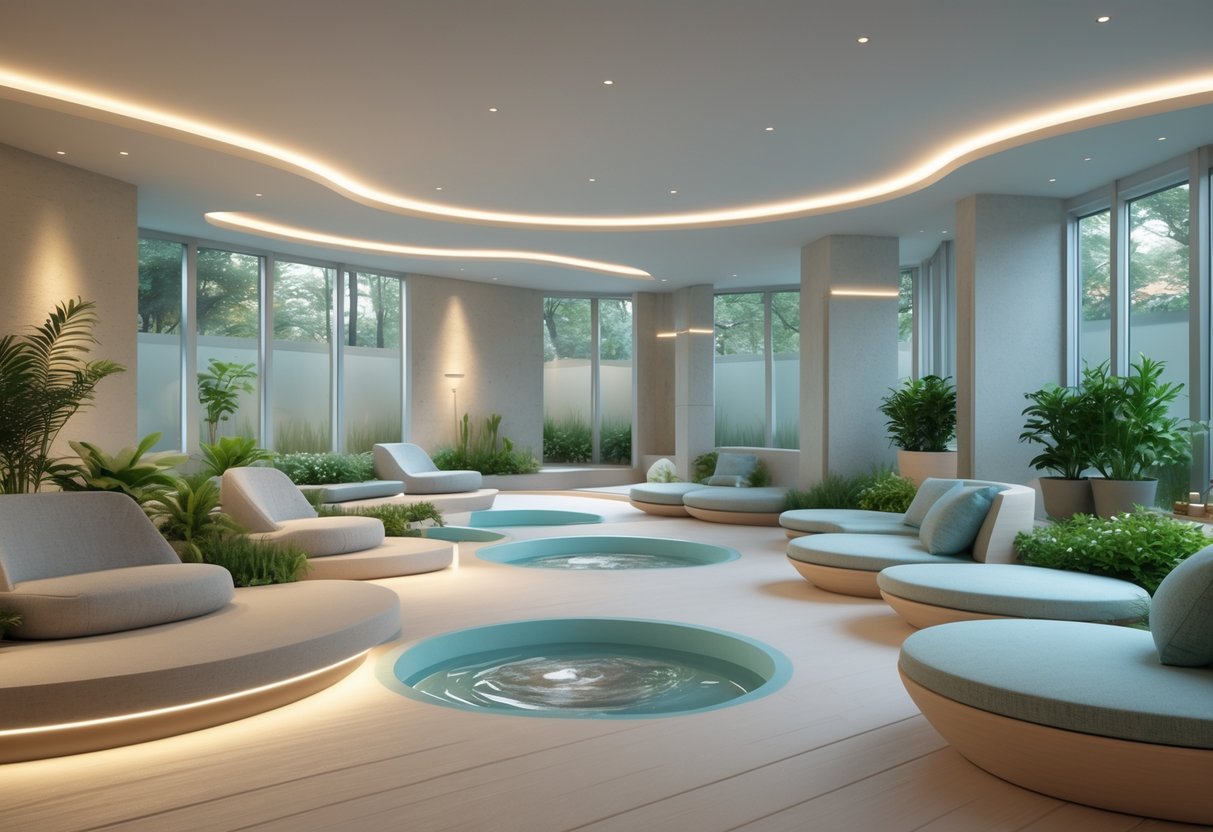
Where you put the cooldown space, what you put in it, and how private it feels will make a big difference. We want a cozy corner that feels safe—not like a punishment.
Selecting the Right Location
Pick a quiet spot away from the action. The best places are in corners or against a wall, so kids aren’t distracted by everything else going on.
Don’t put your calm down space near the main entrance or where groups gather. Kids need a break from the chaos when they’re overwhelmed.
Use natural boundaries if you can. Room dividers, bookshelves, even a curtain can help make the space feel enclosed.
You don’t need a lot of room. A smaller area often feels safer and less intimidating than a whole room.
Think about lighting. Natural light is great, but harsh overhead lights can be too much. If you can, use fairy lights or a small lamp for softer light.
Choosing Furniture and Layout
A bean bag or floor cushions make perfect seats. They’re comfy, don’t take up much space, and aren’t expensive.
If you’re on a budget, even a folded blanket marks the spot. The main thing is to have something soft that says “this is your safe place.”
Keep furniture simple and child-sized. A basket for comfort items and a low shelf for books or sensory stuff is usually enough.
Don’t fill the space with too many choices. Kids who are upset need things to be simple.
Mark boundaries clearly. A small rug shows where the space starts and ends.
Some teachers use painter’s tape on the floor—it’s cheap and works well.
Ensuring Privacy and Comfort
Set up the space so kids can see out, but others can’t easily see in. Kids feel safer that way, and adults can still check in from a distance.
Don’t make it so hidden that kids feel trapped or can’t be supervised.
Add soft textures and calming colors. Soft blues, greens, or greys work better than anything bright or loud.
A pillow, blanket, or stuffed animal can be a lifesaver when kids are overwhelmed.
Use simple visual supports. Maybe a poster with breathing tips or feeling faces.
Keep the text short and use pictures kids understand. Too many posters can distract rather than help.
Make the space inviting, not a punishment. Kids should want to use the cooldown spot because it helps, not because they’re sent away.
Sensory Strategies and Tools
The right sensory tools can really help kids settle their nervous systems when emotions run high. Visual timers add structure, fidgets bring calming input, and deep pressure can ground overwhelmed bodies.
Visual Timers
Visual timers beat regular clocks in cooldown spaces. Kids actually see time moving, so they feel less anxious about how long they’ll stay.
Sand timers work especially well. Watching the sand fall gives kids something peaceful to focus on while they settle their emotions.
Here are a few timer ideas:
- 3-minute sand timer – great for quick resets
- 5-minute visual timer – standard cooldown length
- 10-minute option – for kids who need extra time
Digital timers with visual countdowns can be just as effective. Many show colors changing from red to green as time passes.
Quick win: Start short. Even 30 seconds can help a child who resists the space begin to feel comfortable.
Put timers where kids can spot them easily. This way, you avoid arguments about when cooldown time ends.
Fidgets and Sensory Items
Fidgets help channel anxious energy into calming hand movements. The trick is picking items that calm instead of overstimulate.
Some calming fidgets:
- Stress balls for squeezing
- Pop-it toys for pressing
- Squishy toys that slowly bounce back
- Textured stones for rubbing
Sensory bins are fantastic for younger kids. Fill a small container with rice, beans, or sand, and let them run their fingers through as they calm down.
Noise-cancelling headphones let sensitive kids block out overwhelming sounds. Simple foam headphones can work just as well as fancy electronic ones.
Start with 3–4 fidgets. Too many choices can overwhelm a child who’s already upset. Rotating items every week helps keep things interesting.
Heads up: Stay away from fidgets with small parts or noisy mechanisms. Those just distract other students.
Deep Pressure Techniques
Deep pressure input calms the nervous system in a natural way. It helps kids feel grounded when their emotions leave them scattered.
Weighted items give gentle, steady pressure:
- Weighted lap pads (2–3 pounds)
- Heavy cushions to hug
- Weighted stuffed animals
Body positioning tools let kids apply pressure themselves:
- Bean bags to sink into
- Compression tunnels made from stretchy fabric
- Exercise balls for gentle bouncing while seated
Simple pressure moves kids can do on their own:
- Wall push-ups (10 slow reps)
- Chair push-ups from sitting
- Heavy work like carrying books
- Tight pillow hugs
These activities help regulate a child’s sensory system. The physical input often calms them faster than talking does.
Set up your space so kids can grab these tools on their own. This builds their confidence in handling their feelings.
Incorporating Sensory Input
Kids all need different sensory supports to calm down. Movement activities help release energy and tension, while weighted items give comforting pressure that soothes the nervous system.
Introducing Movement Options
Movement helps regulate emotions through two main sensory systems. One is proprioception, which tells us where our bodies are. The other is the vestibular system, which deals with balance and movement.
A small trampoline is perfect for proprioceptive input. Kids can jump to release tension and get joint pressure that calms their bodies. Put it in a corner so one child can use it safely.
Yoga mats offer a space for stretching, rolling, or simple poses. Laminated cards showing basic movements—like child’s pose or gentle twists—give kids easy visual prompts.
Balance boards give gentle rocking that activates the vestibular system. This slow movement can help anxious kids find their center. Pick boards with handles for younger children.
Resistance bands are great for heavy work. Kids pull, stretch, and push to get deep pressure their muscles crave. Attach them safely to walls or sturdy furniture.
Providing Weighted Blankets
Weighted blankets give deep pressure touch that calms the nervous system. This pressure helps release serotonin and lowers cortisol, so kids feel more settled.
Pick blankets that are about 10% of a child’s body weight. A 4-stone child should use a blanket around 6 pounds. Don’t go heavier than 10%, or the blanket might feel more restrictive than comforting.
Weighted lap pads are good for kids who find full blankets too warm or confining. These smaller pads give pressure to the legs and torso but let arms stay free for reading or quiet play.
Weighted stuffed animals combine a cuddly toy with sensory input. Kids often find these less intimidating than blankets and can hug them close when overwhelmed.
Keep weighted items where kids can reach them on their own. Store them in open baskets or on low shelves so kids can choose what they need.
Auditory Supports
Sound makes a big difference in how kids handle emotions and stress. The right auditory environment blocks overwhelming noise and offers calming alternatives.
Headphones let kids control what they hear. Noise-cancelling headphones block distractions, while regular ones can play calming music or white noise. Pick comfortable, adjustable ones for long wear.
Sound machines give steady background noise that masks sudden sounds. Ocean waves, rain, or gentle humming create predictable input many kids find soothing. Place them away from busy areas to avoid interruptions.
Soft music can help regulate heart rate and breathing. Classical, nature sounds, or instrumental music work best. Skip songs with lyrics—they’re more distracting than calming when emotions run high.
Fidget toys with quiet sounds offer gentle auditory input without bothering others. Soft clicks, gentle chimes, or whispery textures give subtle feedback that can help some kids focus.
Choosing Calming Materials
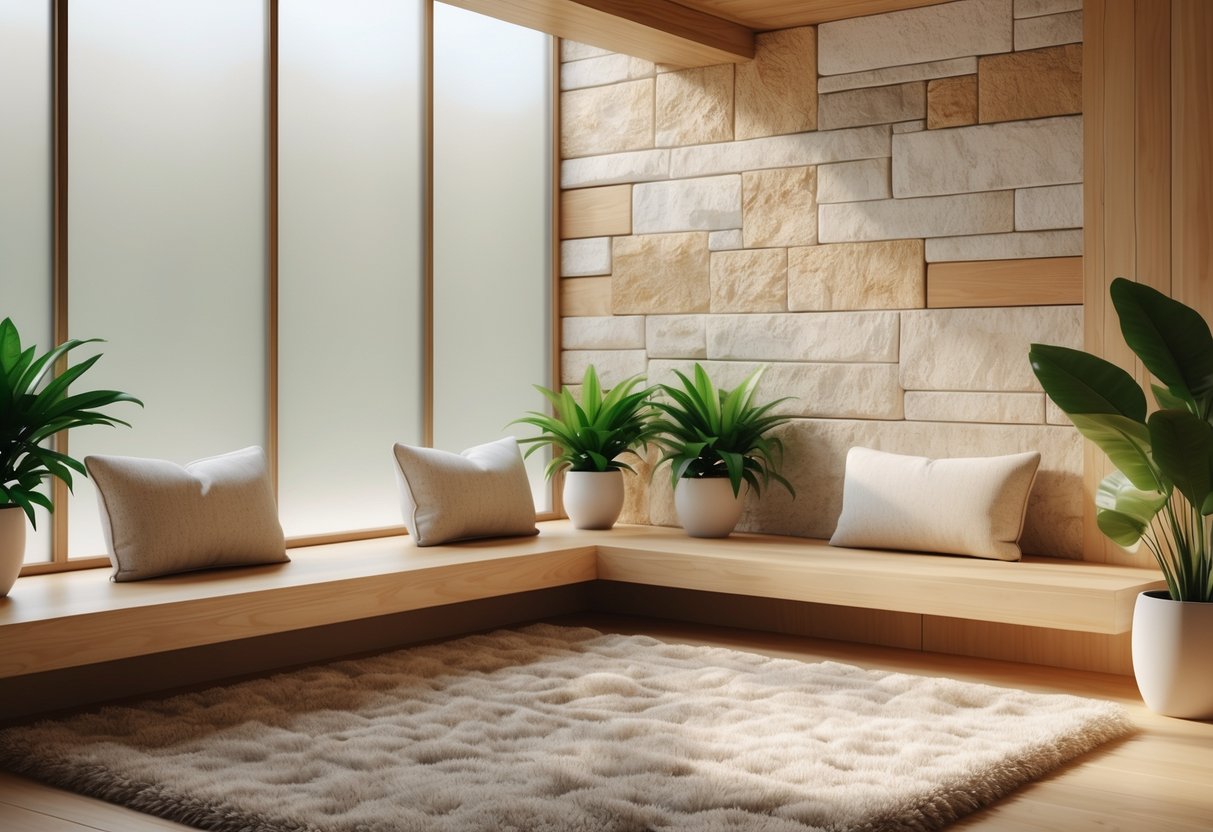
The right materials really shape your cooldown space. Soft textures, interesting books, and familiar comfort items help kids feel safe and practice managing their emotions.
Soft Furnishings
Soft furnishings set the stage for any calming area. Bean bags, cushions, and blankets make a cozy corner where kids feel protected from stress.
A weighted blanket can ground anxious kids with deep pressure. These are especially good for students who need extra sensory input. Make sure to choose the right weight for each child.
Must-have soft furnishings:
- Bean bags or floor cushions
- Soft blankets in soothing colors
- Small rugs or carpet squares
- Weighted blankets (1–3kg for younger kids)
Steer clear of bright patterns or scratchy textures. Neutral colors—soft blues, greens, or greys—work best. Washable materials are a must, since these get used a lot.
Books and Visual Supports
Books about emotions help kids understand their feelings and pick up coping ideas. Look for stories where characters work through tough emotions successfully.
Visual supports like emotion charts and breathing cards give kids simple tools to use. Laminated cards with breathing steps are great for all ages. Kids can follow the pictures instead of remembering instructions.
Helpful visual supports:
- Emotion charts with faces
- Breathing cards with easy steps
- Social story books about feelings
- Mindfulness coloring sheets
Keep the books in good shape and swap them out now and then. Kids pay more attention to fresh options than old favorites.
Comfort Objects
Comfort objects give emotional security when kids feel overwhelmed. Stuffed animals, fidget toys, and sensory tools give them something to hold and focus on as they calm down.
Noise-cancelling headphones can help kids who get overstimulated by classroom sounds. These are especially useful in busy rooms where total quiet isn’t possible.
Popular comfort objects:
- Soft teddy bears or stuffed animals
- Stress balls and fidget cubes
- Sensory bottles with glitter or beads
- Headphones for blocking noise
Let kids help pick out comfort objects. They know what soothes them best and will use things they’ve chosen more often than things handed to them.
Teaching Self-Regulation in Cooldown Spaces
Teaching kids self-regulation takes direct modeling, breathing techniques, and regular emotional check-ins. These three methods work together to help kids understand their feelings and develop coping strategies they can use on their own.
Modelling Calm Behaviour
Kids learn self-regulation best when we show them what calm looks like. When we enter a cooldown space with an upset child, our actions become their guide.
Keep your voice quiet and steady. Kids match the energy we bring. Speak slowly and don’t rush through directions.
Show deep breathing clearly. Place a hand on your chest and one on your stomach. Let kids see your breathing slow down as you calm yourself.
Try simple phrases like:
- “I’m taking three deep breaths.”
- “I’m relaxing my shoulders.”
- “I’m sitting quietly for a moment.”
Demonstrate problem-solving out loud. Say things like, “I notice I feel frustrated, so I’m going to count to ten.”
Kids learn faster when they see adults using these same strategies. It shows everyone needs help managing emotions sometimes.
Practising Deep Breathing Exercises
Deep breathing exercises give kids a tool they can use anywhere. Teach these skills when kids are calm—not in the heat of the moment.
Start with easy counting:
- 4-4-4 breathing: Inhale for 4, hold for 4, exhale for 4
- Balloon breathing: Pretend to blow up a balloon slowly
- Flower breathing: Smell a flower (inhale), blow out a candle (exhale)
Make it visual and fun:
- Use pinwheels or bubbles to show controlled breathing
- Draw breathing patterns on paper
- Create hand gestures that match the rhythm
Practice often but keep it short. Five minutes a day works better than one long session a week.
Connect breathing to body awareness. Ask kids how their heartbeat or muscles feel after they breathe deeply.
Using Emotional Check-Ins
Regular check-ins help kids notice their feelings before things get overwhelming. Simple tools and consistent language build this skill.
Create feeling identification systems:
- Emotion thermometers from 1–10
- Color-coded charts (red = angry, blue = sad)
- Weather metaphors (stormy, cloudy, sunny)
Ask clear questions:
- “What number is your anger right now?”
- “Where do you feel that in your body?”
- “What happened just before you felt this way?”
Check in several times a day. Short, regular chats work better than waiting for big emotions.
Teach kids to check in with themselves. Give them simple questions to ask when they notice strong feelings.
Keep a feelings journal or chart. Track patterns in emotions and what helps. Kids can see their own progress over time.
Engaging Children in the Creation Process
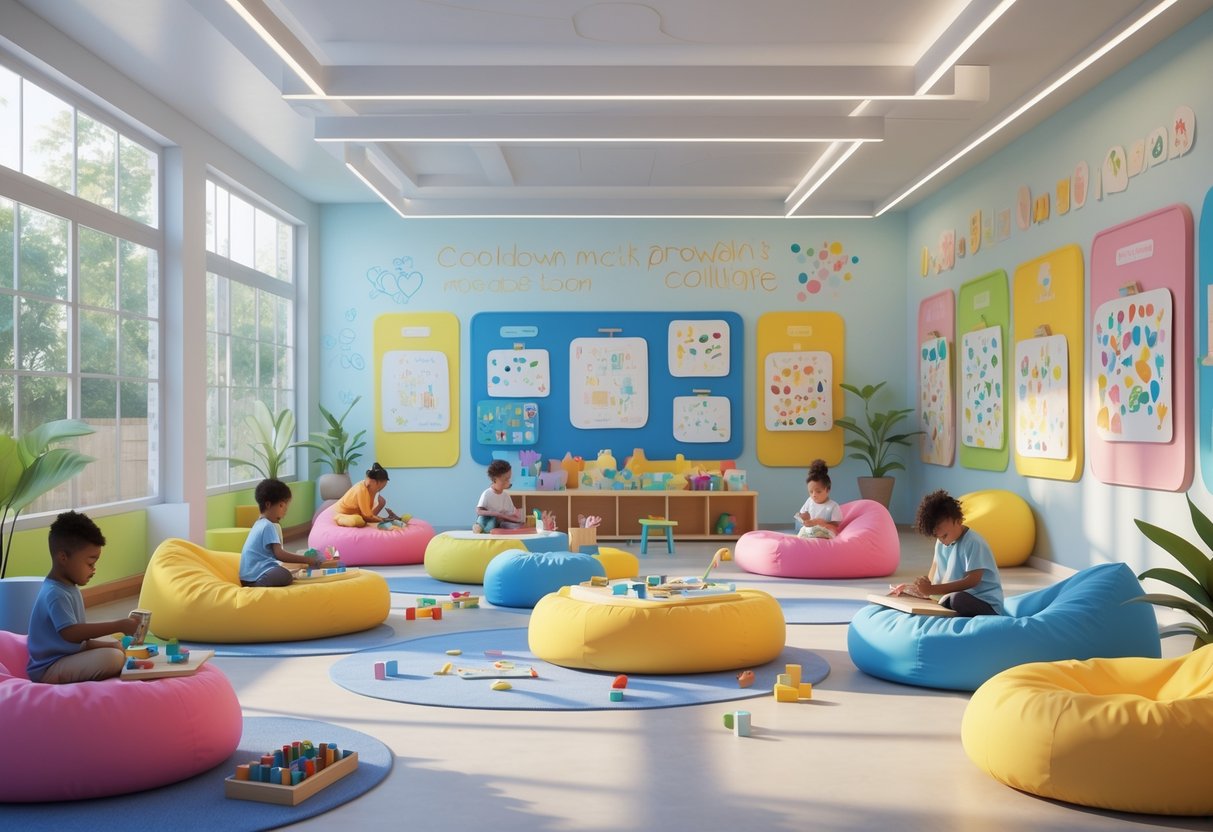
When kids help design their cooldown space, they feel more ownership and build self-regulation skills. Kids who help set up the space are more likely to use it when upset and understand what it’s for.
Letting Children Choose Materials
Letting kids pick what goes in the space makes it theirs. Ask what helps them feel better when they’re stressed or upset.
Common choices kids make:
- Comfort objects: stuffed toys, soft blankets, pillows
- Sensory tools: fidgets, stress balls, textured things
- Calming activities: coloring books, quiet music, headphones
- Visual aids: feelings charts, breathing cards
Let kids try out different materials before picking. Sometimes they think they want loud music but realize soft sounds work better. Some want weighted items, others go for fluffy textures.
Quick win: Make a “try box” so kids can sample different sensory tools for a week before deciding.
Age matters. Younger kids need simple, safe items they can use alone. Older kids might want journals, puzzle books, or noise-cancelling headphones.
Naming the Space Together
Kids love coming up with names for their cool down space. Letting them do this gives them a sense of pride in what they’ve helped create.
Some favorite names kids pick:
- Adventure themes: Hawaii, Mars, Secret Island
- Feeling-focused: Happy Place, Calm Corner, Peace Zone
- Weather-inspired: Alaska, Sunny Spot, Rainbow Room
- Personal favourites: their favorite colors, animals, or characters
If you’re working with a group, let the kids vote. Each child can toss in their ideas and share why they like their choice. This gets everyone excited and makes sure all voices matter.
Heads up: Stay away from names that sound like punishment. Skip things like “Time Out Corner” or “Behaviour Room”—no one wants to feel bad for needing a break.
Naming the space shows kids that cool down areas are positive tools, not spots for when they’ve been “bad.” When they get to pick the name, they see it as their own helpful place.
Encouraging Personalisation
Adding personal touches makes cool down spaces feel special and inviting. Each space should reflect the kids who use it.
Kids can bring in:
- Artwork: their own drawings, favorite pictures, family photos
- Decorations: posters of things they love, fairy lights, plants
- Personal collections: favorite books, little treasures, worry stones
Let kids swap out decorations now and then. What helps in autumn might not do the trick in spring. Kids change and so do their needs.
Quick win: Hand each child a small box or basket for their personal items. They can switch things up as they like.
When kids see their own art or favorite colors, it reminds them this space is theirs. That connection makes them more likely to actually use the space when things get overwhelming.
Kids often surprise us with creative personalisation ideas that fit their needs perfectly.
Integrating Cooldown Spaces Into Routines
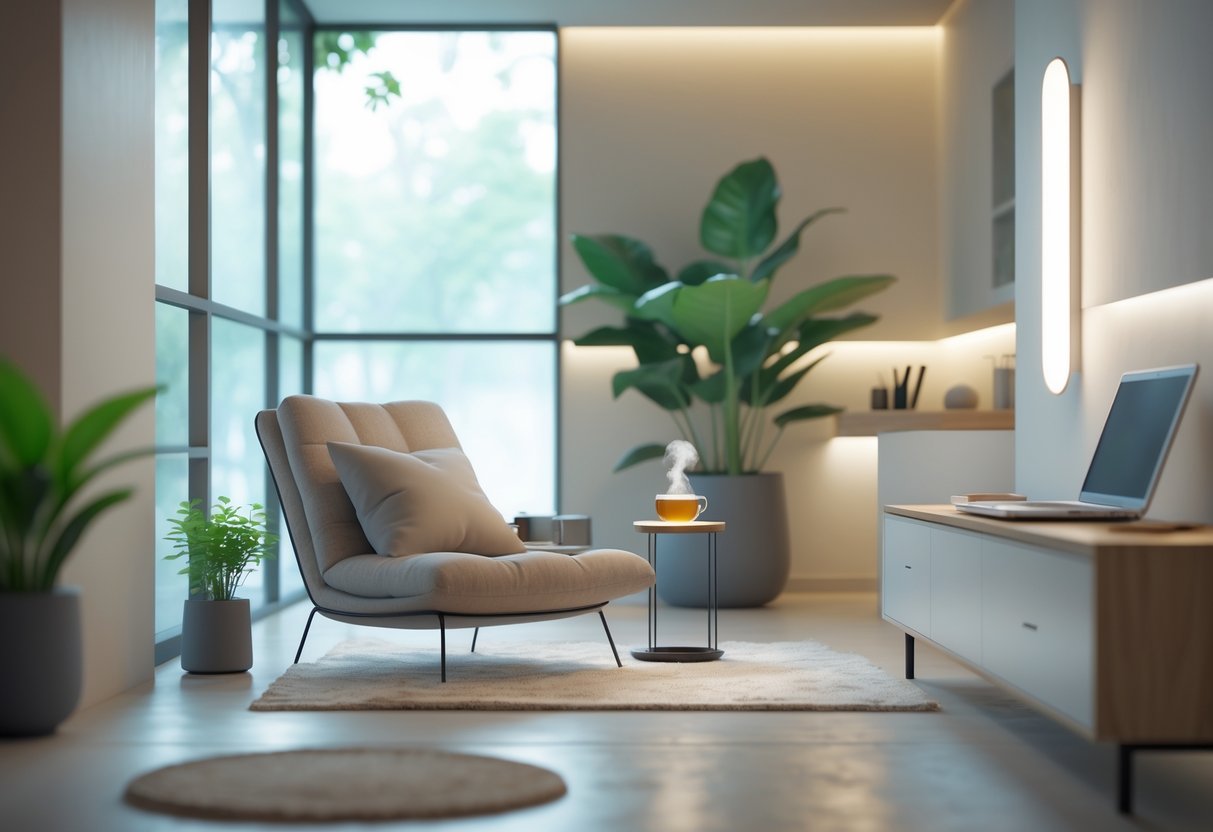
Setting up cooldown spaces takes a bit of structure and regular tweaks. If we want kids to build self-regulation skills, we need to guide them with clear routines.
Success comes from having good rules, sticking to habits, and checking in to see how things are going.
Establishing Guidelines for Use
Clear rules help kids actually use cool down spaces to regulate themselves. We should lay out expectations at the start of each term, using language that makes sense to them.
Key guidelines:
- Walk calmly to the space without bothering others
- Use quiet voices or stay silent
- Stay for about 5-10 minutes
- Come back when you’re ready to rejoin
Let’s model how to use the space during circle time or class meetings. Kids learn best when they watch adults do the “cooldown walk” and use the space the right way.
Key rules to set:
| Behaviour | Expectation | Why It Matters |
|---|---|---|
| Movement | Walk calmly | Keeps classroom peaceful |
| Voice level | Whisper or silent | Lets others focus |
| Duration | 5-10 minutes max | Stops kids from avoiding work |
| Return signal | Student decides when ready | Builds independence |
Staff need to remember: cooldown spaces are voluntary. We don’t send kids there as punishment. They should choose to use the space when they feel overwhelmed or need a break.
Promoting Consistent Practice
When kids use the space regularly, self-regulation gets easier. We should weave cool down practices into daily routines, not just pull them out during meltdowns.
Morning talks about feelings and stress signals help kids recognize when they might need a break. We can teach breathing exercises, counting, and other calming tricks during these times.
- Start each day by reviewing calming tools
- Practice deep breathing as a class
- Talk about different emotions and how to handle them
- Give a shout-out to kids who use the space well
Consistency from all adults is huge. Teaching assistants, substitutes, and support staff need the same info about cooldown space routines.
We should use the space the same way every day—even when things get hectic or we’re frustrated. Mixed messages just confuse kids and make the space less helpful.
Weekly practice ideas:
- Role-play situations where a break might help
- Check which tools work best for different kids
- Update emotion charts and visual reminders
- Make sure materials are in good shape
Tracking Progress and Adjustments
Keeping track shows us if cooldown spaces are actually helping kids regulate. We need simple ways to collect data without making more work for ourselves.
- Mark down how often kids use the space each day
- Jot quick notes weekly about which kids benefit most
- Review behavior incidents monthly
- Assess self-regulation skills each term
Some kids need different things as time goes on. One child might outgrow certain tools, while another needs more sensory supports.
We should switch up materials based on age and needs. Year 1 kids might love stuffed animals and picture cards; Year 5s might want breathing charts and stress balls.
Signs to switch things up:
- Kids never use the space
- The same kids use it too much
- Classroom disruptions go up even with the space
- Tools get ignored or misused
Team meetings give us a chance to talk about what’s working and what’s not. Parents can share what helps their kids at home, which is often super useful.
Monthly review questions:
- Which kids use the space best?
- What tools do they actually use?
- Are kids coming back to class calmer?
- Do we need more training or new resources?
Evaluating and Adapting Cooldown Spaces

Cooldown spaces need regular check-ins to stay useful. We have to keep an eye on what works, swap out what doesn’t, and listen to feedback.
Monitoring Effectiveness
We need clear ways to see if our cooldown spaces are actually helping kids. Simple observation charts can track how often they use the space and how long they stay.
Key things to watch:
- How many times kids use the space each day or week
- Average time spent in the space
- Which sensory tools kids pick most
- Fewer challenging behaviors after using the space
Staff can fill out quick feedback forms to note what’s working. Ask things like “Did the child seem calmer after?” or “Which tools did they use most?”
Kids’ feedback matters too. Even the littlest ones can point to a happy or sad face to show how the space made them feel. Older kids can say which tools helped most.
Weekly review checklist:
- Are sensory tools being used the right way?
- Do kids know how to use the space on their own?
- Are there times when it gets too crowded?
- Which calming strategies work best?
Updating Tools and Strategies
Cooldown spaces get stale if we never change them. Kids’ sensory needs change as they grow and learn new skills.
We should swap out sensory tools every few months to keep things fresh. Weighted lap pads might be great for some, while others want fidget toys or headphones.
Monthly equipment check:
- Replace anything worn out or broken
- Try out one new calming tool
- Remove stuff no one uses
- Make sure lighting and temperature controls still work
Staff need updates, too. When there’s new research or better sensory strategies, we should share that info so everyone stays on the same page.
Switch things up for the seasons. In summer, maybe add gel pads for cooling. Winter? Extra blankets or warm lights might help.
Responding to Changing Needs
Kids’ needs change a lot during the year. What worked in September might not help by March.
We track usage patterns to catch these shifts early. If more kids need the space during certain subjects or times, we can tweak things.
Look for these signs:
- More challenging behavior even though the space is open
- Kids start avoiding the space
- Staff say the space isn’t helping as much
- New kids join with different sensory needs
Some kids outgrow certain tools. A child who needed deep pressure might now prefer movement-based strategies.
Parent feedback helps too. If families find something works at home, we can try similar ideas in our space.
Team meetings let us share what we notice and brainstorm new solutions. Sometimes, just one small change makes a big difference for everyone.
Frequently Asked Questions
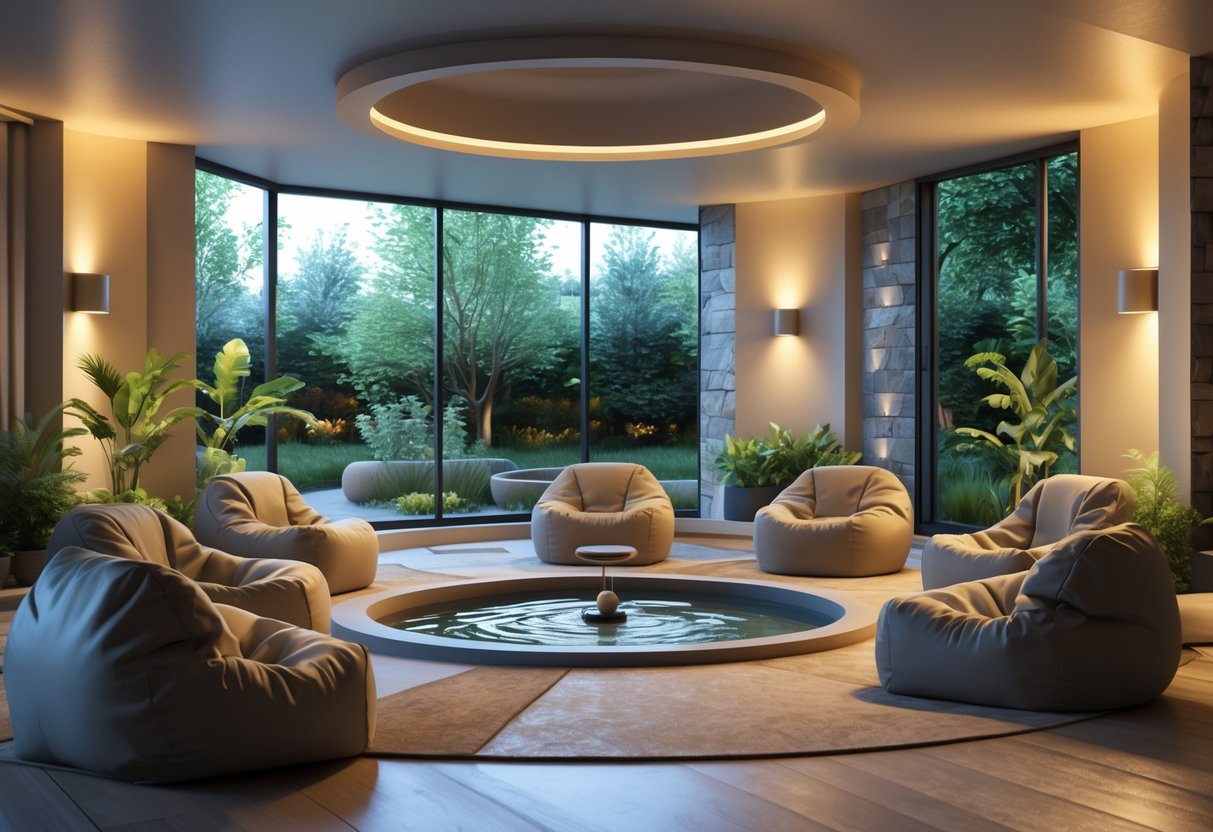
Setting up a cooldown space brings up lots of practical questions about furniture, materials, and what works for different ages. Here are some answers to the most common concerns about making calming spaces work in all kinds of settings.
What are some creative ideas for setting up a calming corner in a primary classroom?
Start with a small rug to mark out the space, then add some cozy cushions or a bean bag. Pick a quiet corner away from busy areas so kids aren’t distracted.
Put up a “feelings thermometer” on the wall so kids can show how they feel. Add a basket with stress balls, fidget toys, and sensory bottles filled with glitter and water.
Hang up posters with simple breathing exercises and kid-friendly pictures. Hot chocolate breathing and star breathing are big hits with little ones.
A stuffed animal or two can be comforting. Lots of teachers say drawing materials like crayons and paper help kids express emotions too.
How can I create an effective calm down space at home for my children?
Pick a spot that feels safe and a bit separate from the main family buzz. Try a corner of their bedroom or a quiet nook in the living room.
Use a tent, reading nook, or just some cushions to mark out the area. The main thing is that the space feels special—not just another play area.
Fill it with calming tools your child actually likes. This could be favorite books, soft blankets, or quiet toys like puzzle balls or kinetic sand.
Set simple rules about when and how to use the space. Make sure your child knows it’s not a punishment—just a place to feel better when things get tough.
What items are essential for a calming spot aimed at helping adults de-stress?
Adults need different sensory tools than kids. Try noise-cancelling headphones and calming music or nature sounds.
Pick comfortable seating like a supportive chair or meditation cushion. Good lighting matters—a soft lamp is better than harsh overhead lights.
Add things for mindful activities: adult coloring books, journals, or meditation apps. Some adults like essential oils or calming scents.
Keep work stuff and electronics out of the space. The idea is to make a clear break from daily stress.
In what ways can I make my calm down zone engaging for middle school pupils?
Middle schoolers want more grown-up tools than little kids. Journals for writing about feelings or situations work well.
Add fidget tools that don’t look babyish—stress cubes, thinking putty, or small puzzles. Problem-solving activities often appeal to this age.
Hang up posters about conflict resolution and managing peer relationships. Social stuff is a big deal for them.
Let students help decide what goes in the space. They’re more likely to use it if they help shape it.
Could you suggest some resources for printable materials to enhance a peace area?
Lots of teachers make their own feeling charts with faces showing different emotions. Kids can point to these when they can’t find the right words.
Printable breathing guides are great. Simple pictures showing balloon breathing or counting breaths help kids focus.
Expectation posters help too—clearly list what students can do in the space, time limits, and what’s okay.
Try making “cool down passes” for teachers to give kids who need a break. It’s a low-key way to help kids take space without a big fuss.
What types of furniture are best suited for a serene retreat within a learning environment?
Soft seating like bean bags or floor cushions really set the tone. They’re comfy and don’t feel intimidating at all.
Try adding a small bookshelf or some kind of storage to keep calming materials handy. I always go for pieces with rounded edges—they just feel safer.
You might want a little table or writing spot for drawing or journaling. It gives students a way to choose what helps them relax.
Skip anything that’s too bulky or fancy. You want the area to feel inviting, not overwhelming, and it shouldn’t crowd the classroom.

